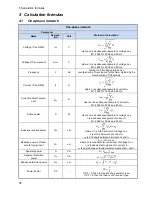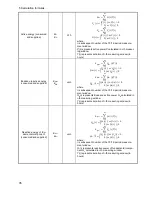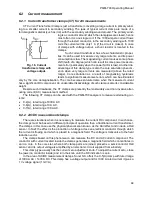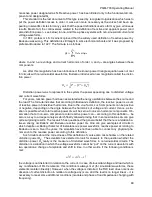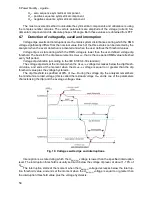
PQM-700 Operating Manual
46
offsets these fluctuations almost totally.
The tests have proved that maximum arduousness occurs at the frequency of about 9 changes
per second. The most sensitive light sources are traditional incandescent bulbs with tungsten fila-
ment. Halogen bulbs, which filaments have much higher temperature, have also much higher inertia
which reduces the perceived brightness changes. Fluorescent lamps have the best flicker “re-
sistance”, as due to their some specific properties they stabilize the current flowing through the lamp
during the voltage changes, and thus reduce the fluctuations.
Flicker is measured in so-called perceptibility units, and there are two types of flicker: short-
term P
ST
which is determined once every 10 minutes, and long-term P
LT
which is calculated on the
basis of 12 consecutive P
ST
values, i.e. every 2 hours. Long measurement time results directly from
slow-changing character of this phenomenon
– in order to collect a reliable data sample, the meas-
urement must be long. P
ST
equal to 1 is considered a value on the border of annoyance
– certainly
sensitivity to flicker is different in different people; this threshold has been adopted after tests carried
out on a representative group of people.
What causes flicker? Most frequently, the reason is the voltage drop as a result of connecting
and disconnecting large loads and some level of flicker is present in the majority of mains systems.
Disregarding the unfavorable effect on humans described above, flicker does not need to be
– and
usually is not
– a symptom of malfunctioning of our installation. However, if a rather abrupt and
unexplainable flicker level increase is observed in the mains (increase of P
ST
and P
LT
), this should
not be ignored under any circumstances. It may turn out that the flicker is caused by unsure con-
nections in the installation
– increased voltage drops on connections in the distribution panel (for
example) will result in higher voltage fluctuations on the receivers, such as light bulbs. The voltage
drops on connections also cause their heating, and finally sparking and possibly a fire. Periodical
mains tests and described symptoms can turn our attention and help find the source of hazard.
6.4
Power measurement
Power is one of the most important parameters defining the properties of electrical circuits. The
basic magnitude used for financial settlements between the supplier and the consumer is electric
energy which is the power multiplied by time.
A few different power types can be found in electrical engineering:
active power, designated as P and measured in watts,
reactive power, designated as Q, unit is var,
apparent power, S, unit is VA.
These three types of power are the most known, but there are also other types.
At school we are taught that these three power types make up a so-called power triangle which
properties are expressed by the following equation:
P
2
+ Q
2
= S
2
This equation is however correct only for systems with sinusoidal voltage and current wave-
forms.
Before a more detailed discussion about the power measurement, individual types of power
should be defined.
6.4.1 Active power
Active power P is a magnitude with precise physical meaning and it expresses the ability of a
system to perform a given work. It is the power most desired by the energy consumers and it is for
this supplied power that the consumer pays the supplier in a given settlement period (the problem
of fees for additional reactive power is discussed separately
– see below). It is the active power
(and consequently, the active energy) which is measured by electric energy meters in each house-
hold.
Basic formula to calculate the active power is as follows:
Summary of Contents for PQM-700
Page 85: ...85 Notes...


